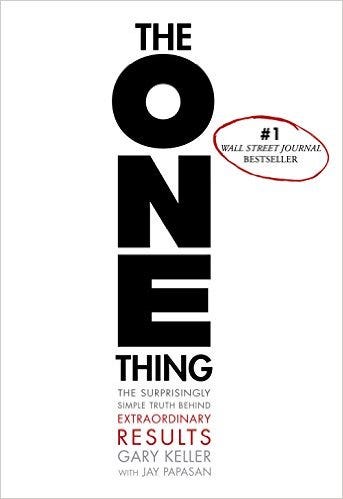This book explains with amazing clarity the process of accomplishing big goals

Thought precedes actions. And extraordinary thought precedes extraordinary actions.
Prioritize the important things
Apply the 80/20 principle to your to-do lists. The Pareto principle or 80/20 principle applies to nearly everything. One example is given by Joseph M. Juran, a quality-control management pioneer at General Motors. He found out that about 80% of the flaws or defects in the production of cars came from only a handful (about 20%) of production flaws. Fixing these flaws became the highest priority.
The same is probably true on your to-do list. Some of the tasks will have the biggest impact, focus on these.
Focus means saying NO
When Steve Jobs was famously proud of projects, he didn’t pursue. After his comeback to Apple in 1997, he reduced the company’s output from 350 down to just 10 products. He explained at a developer’s conference in 1997 that “Focusing is about saying no.”
Learn to say no. Your time and resources are limited. You must be prepared to say no to everything else if you want to focus on the important things. Saying no does not mean being selfish. You can always come up with another solution or helpful advice which doesn’t require your assistance.
The focus question
One question can help you focus and know exactly where you want to go and how you can get started: “What’s the ONE thing I can do, such that by doing it everything else will become easier or unnecessary?”
The amazing thing is that this question can both be applied on a macro and a micro scale. On a macro scale, it can help you focus on your biggest goal in life or your overall career, and on the micro scale, it could help you focus on the short-term level, selecting the best task to start with. For example doing some research or talking to someone.
The first question is to define your direction. The second question is to choose the right action.
Sequential habit forming
Discipline requires Willpower, and Willpower is limited. The best thing is to use discipline to form enduring good habits.
Even people with attention deficit hyperactivity disorders can apply the strategy of habit building successfully. First, focus all your discipline into forming one habit. Once your habit is well established it becomes much easier to maintain, then you can focus your discipline or willpower to form a new habit.
That is sequential habit building in a nutshell. Build one habit after the other. Whenever it is easy to maintain a new habit, you can start focusing on building the next one.
Multitasking is horribly inefficient
The name multitasking was coined to describe how computers with one processor could work on multiple tasks simultaneously. But they did it not in parallel, but switching back and forth between multiple tasks in rapid succession. Our brain works in much the same way. There are things we can do in parallel, for example walking and talking on the phone, but our ability to focus efficiently is limited to one task only.
What happens when we do something like walking and talking on the phone, is that our brain switches its attention from one task to the other just as a computer. This switching has shown to take time, as we have to refocus each time. The penalty may be small in simple tasks like talking on the phone, but they increase greatly when the returning task is more complex.
For example, if you are a programmer about to debug a complex error in your software and someone interrupts you, you will have a hard time refocusing and starting over. Over time these penalties add up.
It has been estimated that distractions count for one-third of office workers working day, as they get distracted every 11 minutes on average.
Visualize and have a purpose
Imagine if you would live your day to day without ambitions and goals. How would you decide what to do take decisions and prioritize? With this example, it is easy to come to the conclusion that a purpose or life goal is important for a sense of direction. It is easier to take fast decisions, have more conviction and clarity of thoughts, if one a strong sense of direction or purpose.
Perhaps even more importantly, knowing WHY you are doing something gives you inspiration and motivation which will help you go through adversity.
Once you have a clear goal in place, start visualizing each step which will lead you along the way to your goal. Visualization will give you additional motivation and preparation for the road which lays ahead.
Don’t compromise your personal life
Never compromise your personal life for your professional goals. If you let down your personal life, the damage can be irreparable. Instead prioritize your work time ruthlessly. In your work, you can neglect the non-important stuff and focus exclusively on what matters most. This strategy will let you achieve your goals while maintaining a balanced life.
A quick recap
Ask yourself the focusing question every day
Prioritize your to-do lists
Stop multitasking
?Click here to get this Masterpiece and start focusing on the ONE thing.?
